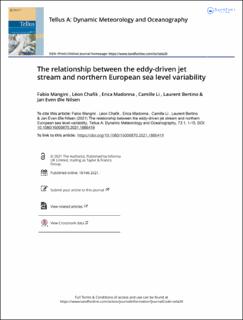| dc.contributor.author | Mangini, Fabio | |
| dc.contributor.author | Chafik, Léon | |
| dc.contributor.author | Madonna, Erica | |
| dc.contributor.author | Li, Camille | |
| dc.contributor.author | Bertino, Laurent | |
| dc.contributor.author | Nilsen, Jan Even Øie | |
| dc.date.accessioned | 2021-07-05T12:02:28Z | |
| dc.date.available | 2021-07-05T12:02:28Z | |
| dc.date.created | 2021-02-19T09:15:00Z | |
| dc.date.issued | 2021 | |
| dc.identifier.issn | 0280-6495 | |
| dc.identifier.uri | https://hdl.handle.net/11250/2763407 | |
| dc.description.abstract | Wintertime sea level variability over the northern European continental shelf is largely wind-driven. Using daily gridded sea level anomaly from altimetry, we examine both the spatial and the temporal relationship between northern European sea level variability and large-scale atmospheric circulation patterns as represented by the jet cluster paradigm. The jet clusters represent different configurations of the eddy-driven jet stream and, therefore, provide a physical description of the atmospheric variability in the North Atlantic. We find that each of the four jet clusters is associated with a distinct northern European sea level anomaly pattern whose magnitudes are comparable to those of typical sea level variations on the shelf. In certain locations, such as the German Bight and the east coast of England, sea level anomalies are mainly associated with one single jet cluster. In other locations, such as the interior and the northern part of the North Sea, sea level anomalies are found to be sensitive to at least two jet configurations. Based on these regional sea level variations, we map out the locations on the shelf where each jet cluster or combination of clusters is most active before discussing the role of Ekman transport in inducing the resulting patterns. Through a multiple linear regression model, we also find that the jet clusters reconstruct up to 50% of the monthly mean sea level anomaly variance over the northern European continental shelf. The model best performs in the interior and the western part of the North Sea, suggesting that wind direction rather than wind speed plays a more prominent role over these regions. We conclude that the jet cluster approach gives valuable new insights compared to linear regression techniques for characterising wind-driven sea level variability over the northern European continental shelf. | en_US |
| dc.language.iso | eng | en_US |
| dc.publisher | Taylor and Francis | en_US |
| dc.rights | Navngivelse-Ikkekommersiell 4.0 Internasjonal | * |
| dc.rights.uri | http://creativecommons.org/licenses/by-nc/4.0/deed.no | * |
| dc.title | The relationship between the eddy-driven jet stream and northern European sea level variability | en_US |
| dc.type | Journal article | en_US |
| dc.type | Peer reviewed | en_US |
| dc.description.version | publishedVersion | en_US |
| dc.rights.holder | Copyright 2021 The Author(s). | en_US |
| dc.source.articlenumber | 1886419 | en_US |
| cristin.ispublished | true | |
| cristin.fulltext | original | |
| cristin.qualitycode | 2 | |
| dc.identifier.doi | https://doi.org/10.1080/16000870.2021.1886419 | |
| dc.identifier.cristin | 1891610 | |
| dc.source.journal | Tellus A: Dynamic Meteorology and Oceanography | en_US |
| dc.identifier.citation | Tellus A: Dynamic Meteorology and Oceanography. 2021, 73, 1886419. | en_US |
| dc.source.volume | 73 | en_US |
| dc.source.issue | 1 | en_US |

